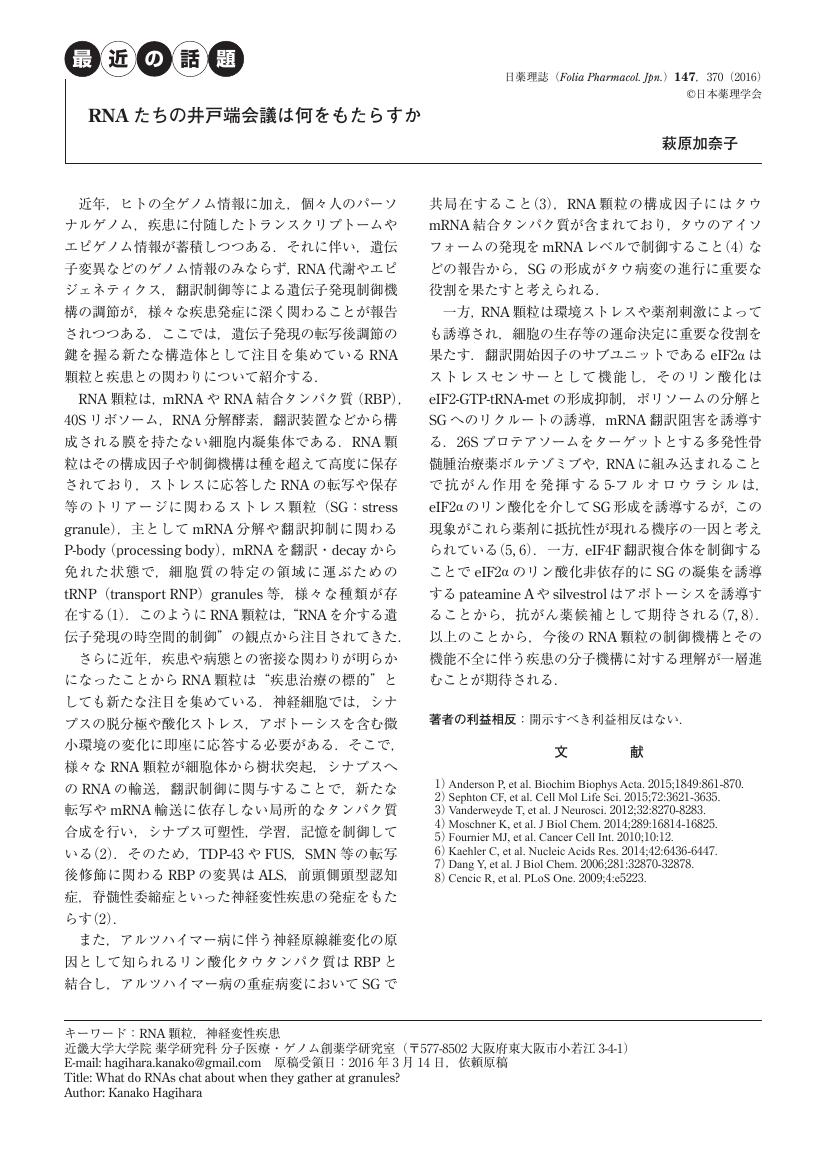2 0 0 0 OA シグナル制御拠点としてのRNA顆粒の役割~RNA顆粒によるシグナル伝達分子の空間的制御~
- 著者
- 佐藤 亮介 萩原 加奈子 喜多 綾子 杉浦 麗子
- 出版者
- 公益社団法人 日本薬理学会
- 雑誌
- 日本薬理学雑誌 (ISSN:00155691)
- 巻号頁・発行日
- vol.147, no.6, pp.340-345, 2016 (Released:2016-06-11)
- 参考文献数
- 25
ERK MAPK経路やPI3K/Akt経路といった細胞内シグナル伝達機構は真核生物に高度に保存されており,細胞増殖や分化,アポトーシスといった様々な生命現象を制御している.このようなシグナル伝達機構に破綻が生じると,がんや自己免疫疾患,糖尿病,神経変性疾患などの疾病の引き金となることが知られている.したがって,シグナル伝達機構の制御機構を明らかにすることは,病態のメカニズム解明にとどまらず,疾病治療という観点からも極めて重要である.近年,シグナル伝達ネットワークを時空間的にダイナミックに制御する機構として,「RNA顆粒」という構造体が注目を集めている.ストレス顆粒やP-bodyといったRNA顆粒は,ポリ(A)+ RNAやRNA結合タンパク質などから構成されており,mRNAのプロセシングや分解,安定化といった転写後調節に関わる「RNAの運命決定装置」として発見された.我々は酵母遺伝学とゲノム薬理学的研究を展開することにより,MAPKシグナル依存的にストレス顆粒に取り込まれるRNA結合タンパク質を同定し,MAPKシグナルがストレス顆粒の形成を制御していることを見出した.さらに,カルシウムシグナルのキープレーヤーであり,免疫抑制薬FK506の標的分子でもあるSer/Thrホスファターゼ「カルシニューリン」がストレス顆粒に取り込まれることで,カルシニューリンシグナルが空間的に制御されていることを見出した.このような「ストレス応答やシグナル制御の拠点」としてのRNA顆粒の役割に関して種を超えた理解が進みつつあり,異常なRNA顆粒の形成と神経変性疾患やがんなどの病態との興味深い関係が浮かび上がりつつある.本総説では,我々の研究が明らかにしたシグナル伝達制御とRNA顆粒との関わり,その疾患治療への応用の可能性について紹介する.
2 0 0 0 OA RNAたちの井戸端会議は何をもたらすか
- 著者
- 萩原 加奈子
- 出版者
- 公益社団法人 日本薬理学会
- 雑誌
- 日本薬理学雑誌 (ISSN:00155691)
- 巻号頁・発行日
- vol.147, no.6, pp.370-370, 2016 (Released:2016-06-11)
- 参考文献数
- 8
- 著者
- 萩原 加奈子
- 出版者
- 一般社団法人 日本学校保健学会
- 雑誌
- 学校保健研究 (ISSN:03869598)
- 巻号頁・発行日
- vol.64, no.4, pp.313-321, 2023-01-20 (Released:2023-01-31)
- 参考文献数
- 45
Background: With the widespread use of the internet, children have been exposed to health-related information provided in multiple modes, such as text, numerical and video formats from various sources. It is imperative that children develop health literacy in order to make their own medical and health decisions based on reliable information that is appropriate for them. However, the level of health literacy among adults in Japan is lower than in eight EU countries and six other Asian countries. Acquiring health literacy at an early age is an urgent issue. Objective: Through a thorough literature review, the present study examined the feasibility of employing a comprehensive health literacy scale for children in Japan and overseas. Methods: A literature search was conducted on PubMed, PsycINFO and CiNii Articles for health literacy scales that targeted participants aged under 20 years. Each item on the available scales was classified in accordance with the 14 components of health literacy for children and youth, which Bröder et al. (2017) identified, as well as the eight components of health education content of the Curriculum Guidelines of the Japanese Ministry of Education, Culture, Sports, Science and Technology for defining the basic standards for education. Results: In total, 21 scales were found, including 17 from outside Japan. Four of the questionnaires were unavailable, thus leaving 17 scales for examination. All 17 scales were developed between 2000 and 2020, and reliability was confirmed for 13. Among 17 scales, all four health literacy skills (accessing, understanding, appraising and applying) were included with eight. Several scales included child-specific components, such as communication and self-efficacy. Regarding health education content, health promotion was included in all 17 scales; the use of medical facilities, mental health, environment, and health was incorporated in several scales. Most of the scales were self-administered and involved questions about subjective experiences; however, some scales employed objective measures, such as of health knowledge and BMI. Conclusion: Numerous scales have been developed in Japan and overseas; the assessment methods and components of health literacy and health education content differed among them. In Japan, the HLS-Child-Q15 for elementary school students aged 9 years and above and the MOHLAA-Q for junior and senior high school students aged 14 years and above are notable. With other scales, it is necessary to make a selection based on differences in the components of health literacy and health education content.
